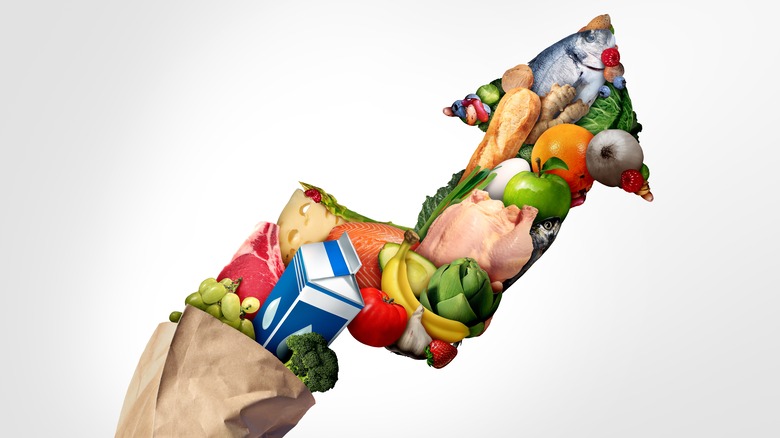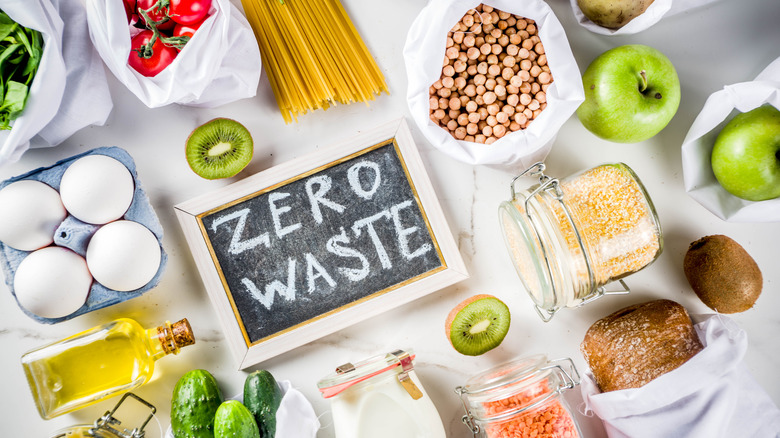How Rising Food Costs Encourage Chefs To Repurpose Food
Before the pandemic, experts warned that our current food supply system was not sustainable. The pandemic forced businesses to shut down, causing a ripple in the supply chain. War, climate change, disease, and political factors stressed the global food system before COVID rocked it. According to Reuters, these factors contributed to global food prices rising a staggering 13% in March, a new record high.
The war in Ukraine spiked prices for wheat, corn, barley, and sunflower oil since a third of the global supply of wheat and barley and two-thirds of sunflower oil come from Russia and Ukraine. In addition, Ukraine is the fourth largest exporter of corn. With ports and infrastructure damaged from the war and crops being left unharvested, we expect prices to continue to rise on products sourced from those crops, including cereal and animal feed (via Reuters).
Global warming continues to impact the supply chain, like Brazil's drought in 2021, which affected the world's largest soybean producer. Like Americans in 2020 with toilet paper, entire nations are hoarding crops for fear of another pandemic. Indonesia has banned the exportation of palm oil, reserving its stock for consumption, just in case.
The most significant price increases can be found in the meat category, due partly to animal diseases like avian flu and swine fever. Beef and veal prices rose 9.6%, while pork spiked by 6.3% and poultry by 5.6% (via USDA). Inflation has affected the cost of food at the supermarket and dining out, making chefs get creative in the kitchen to keep margins up.
Repurposing fruit and vegetables
The restaurant business is notoriously difficult, with eighty percent failing before their fifth anniversary. Unforeseen events like the pandemic made it exponentially more difficult. Restauranteurs have two costs under their control: food and labor referred to as "prime costs" in the industry. Restaurants aim to keep their prime costs between sixty and sixty-five percent to be profitable. Since the fruit and vegetable category grew the smallest percent, 1.1%, compared to the increase of 9.3% for beef and veal, chefs are looking to protect their margins by using more produce in their dishes.
According to Restaurant Business Online, chefs are approaching this from several angles. Some restaurants are substituting larger vegetables, like giant spuds, to make up for plating smaller steaks, while others are getting creative with food waste, upcycling what would've been trash. Maeve Webster, president of Menu Matters, suggested that chefs should approach vegetables the same way meat is, varying taste and texture. Making veggies interesting.
Restaurants have traditionally created less waste than the home cook. Broccoli stems are used in stir-fries and chicken bones in stocks, whereas those items end up in the garbage in most U.S. homes. Restaurateur Kimberly Zabriskie of Portland, ME, explains that restaurants can't afford the cost associated with trash services by throwing away food they purchased, paying on both ends. According to the "Food Waste Reduction Alliance," restaurants are throwing away 85% of unused food, totaling 25,000 to 75,000 pounds of waste annually (via Business Insider).
Zero waste restaurants
A growing number of chefs are addressing our food system by forming Feedback, vowing to end food waste by focusing on the hypocrisy in the current model. Currently, the industry is driving deforestation, overfishing, and the depletion of nutrients in the soil while responsible for a quarter of greenhouse gases. Ultimately, we end up throwing away more than half of the food produced, roughly 1.3 billion tons globally. All while almost ten percent of the world's population is food insecure.
Chef Dan Barber of the Michelin-starred restaurant Blue Hill at Stone Barns in New York has been championing this cause since 2015 with his pop-up restaurant "WastED," which stands for "waste education." Barber, also a member of Feedback, is trying to change the culture by demonstrating how skill and technique can transform food waste into delicious dishes like the discarded pulp from juice bars upcycled into veggie patties. Part of Barber's mission involves educating, so a reservation at his restaurant includes a tour of the grounds for ninety minutes before dining, as Barber explains his concept.
The need and response are global. Zero-waste restaurants are popping up worldwide, along with manufacturers like Barnana, which upcycles organic bananas headed to the trash into delicious snacks. The tech industry is also responding with apps like Copia, which allows restaurants to schedule food pickups, donating their food surplus. Along with the USDA and EPA's goal to reduce food waste by half by 2030, there are everyday tasks that can make a significant impact.


